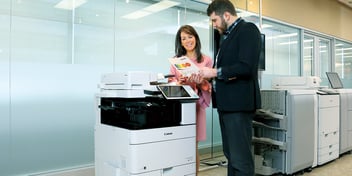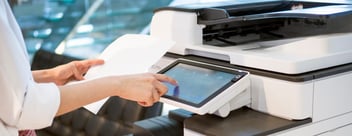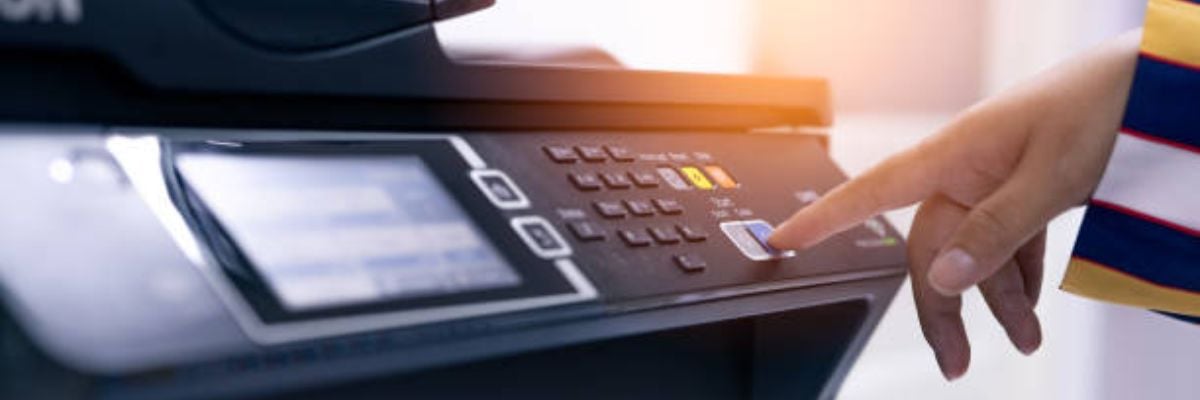By: Darrian Breedlove, Content Writer on April 1st, 2022
Leasing vs Purchasing Copiers; which is right for your business?
Imagine you purchase a copier costing $10,000 for your business. It's perfect for the focus of your company and all you need it to be. However, what happens as the years go by and technology continues to advance? What if there are no upgrades available for your older, outdated copier? You paid $10,000 for a copier that will likely be obsolete in half a decade. But what if your company wants to purchase a device and be done with it in one purchase without paying interest?
To Lease or Not to Lease?
Is leasing or purchasing a copier the best decision for your business? When it comes to leasing or purchasing, many factors play a role. Are you ready to spend a large sum of money upfront and be done with it? Or would you rather have a payment plan to pay off the equipment month by month? Do you print frequently or not that often?
Every business has a unique situation, and managed print providers work with clients to understand their environment and determine which makes sense financially and logistically. To determine what is best for your business, here are some of the biggest pros and cons of leasing and purchasing your copier.
Pros of Purchasing Your Copier
Some of the biggest pros of purchasing your copier are not having interest rates and not being tied to any lease with a technology partner.
No Interest Payments
Purchasing a device can be great if you have sizable cash reserves. A purchase involves a one-time payment for the price of the equipment. This eliminates the need to make interest payments throughout a payback period, resulting in a better Return on Investment (ROI).
In simpler terms, you will pay upfront when purchasing a copier, say for $10,000. This is different from a lease, where, typically, you're paying interest on the copier. If you can pay $10,000 upfront, you will spend less money than you would by the end of your lease. For example, say you spend $203 a month for a 60-month lease; it would cost you $12,180, which is $2,180 more than if you had paid the $10,000 upfront.
Purchase
| One Time Payment | $10,000 |
| Total Paid | $10,000 |
Lease
| Monthly Payment | $203 |
| Total Paid After 60 Months | $12,180 |
Flexibility to Switch Technology Partners
Purchasing gives the flexibility to change your maintenance contract to another vendor. If you become dissatisfied with the level of service you're receiving from your current vendor, you can make a change at will. A service can be switched anytime. The ease of switching depends on whether it is a value lease (includes print allowance in payment) or a straight-up lease that bills equipment and service separately.
Cons of Purchasing Your Copier
The cons of purchasing a copier typically include paying a large sum upfront. Your equipment will also not be automatically refreshed to ensure it functions at the highest quality.
Large Upfront Expense
Purchasing equipment can require a significant upfront investment that many organizations need help to afford. Many companies don't want to tie up $10,000-50,000 in an asset when they could pay monthly for it. Companies need the money they save by paying monthly instead of paying fully for a device. After all, there are other expenses a company has to worry about as well, like payroll, electric bills, etc.
Depreciation is the gradual deduction of price over an asset’s expected longevity. As with any sort of asset, the worth and price will decrease over time as newer and better replacements of that asset come along. With tax implications, you can take only a tiny fraction of the purchase value of a device as a depreciable monthly expense. This reduces tax liability, but less than with an ongoing lease. For your specific situation, we recommend consulting with your trusted tax professional.
Equipment Becomes Outdated
Suppose you purchase equipment intending to use it for an extended period. Typically, equipment needs to be replaced every seven years. After this amount of time, the copier will become outdated and unreliable.
As technology evolves, almost anything you buy will soon become outdated. Once your copier becomes obsolete, it will likely need frequent servicing to fix issues that arise. The problem with old copiers is that it can become challenging to find replacement parts. Manufacturers are only required by law to continue making parts for up to seven years after the new copier is released.
Pros of Leasing Your Copier
The pros of leasing are that you can make small monthly payments, and your equipment is continually refreshed.
Low Upfront Cost and Predictable Payments
Leasing can allow your organization to acquire a multifunction device with little or no upfront cost. From a cash standpoint, leasing allows you to spread out the cost of the equipment over a set period. This will enable you to plan all payments every month, removing the uncertainty of unexpected repairs or replacements that were not budgeted for.
Every business can relate to having fixed budgets for certain things. For non-profit organizations, everything is on a budget. Let's say a company needed five devices costing $60,000 a piece. This would be difficult to budget. With leasing, a $60,000 expense every seven years would only require a budget of $1200 a month for lease payments.
Finding a part that goes with an older piece of equipment could also be a timely and expensive process. Updating your equipment regularly can eliminate this issue through a lease. Leasing companies are typically the ones to cover the maintenance costs. Having upgrades already covered ensures you don't need to worry about high unexpected costs.
Refreshed Equipment
Leasing enables you to ensure equipment is regularly updated. It's best practice to update your equipment every three to four years. When you grow tired of the older copier you are utilizing, you can always switch it out for a newer model. This helps keep your business at the forefront of newer and better technology, including better security, longer life for supplies, and fewer visits for repairs, which keeps you consistently up and running.
Imagine your company leased a device, and it gets hacked one day, immobilizing it. You find there is no more firmware for this device, or it can’t be upgraded any longer. The good news is that you can upgrade to a newer device with updated features and firmware, and all you would've lost is the money paid for using the machine instead of the entire purchase price. It is the best avenue for those who want to stay current in a rapidly evolving technology landscape. This can also save you from paying costly and unpredictable service fees that typically occur with older equipment.
Cons of Leasing Your Copier
The cons of leasing your copier are that you don't own the equipment and will pay interest on the copier over time.
You Don't Own the Equipment
When you lease, you don't own the equipment and therefore have no equity. The equipment cannot be sold at the end of its usable life, and you won't receive any investment back. After hitting the seven-year mark, a copier has zero to no value. Lack of ownership may exempt you from certain tax benefits simply because the asset's value needs to be added to your financial books.
You can purchase the equipment after the lease is up, but the equipment needs to be updated and refreshed. It may leave you with a piece of equipment that requires expensive repairs.
High Interest Payments
When leasing, you will have to pay a higher cost over time than paid with an upfront purchase. Think about when you lease a car. Obviously, cars cost thousands of dollars, and for some can be challenging to produce all that money upfront. Leasing the car is a useful option–you don’t have to pay all of that money right then and there, and can instead do monthly payments.
However, you will learn that leasing the car and paying monthly instead of upfront, leads to you paying more for the car over time compared to the cost of a one-time payment. This is due to the interest incurred in each payment, which will cause the overall cost of the equipment to be higher for the business.
These interest payments vary. For instance, it is essential to remember that interest payments on a lease will be higher if it is a dollar buyout lease vs. Fair Market Value.
The dollar buyout lease means you pay a higher monthly fee, and at the end of the lease, you can buy the equipment out of the lease for a dollar. The fair market value lease is much more common. You pay lower interest on the equipment, and when the lease ends, you refresh the equipment to a newer model.
What are the Next Steps for Leasing or Purchasing Your New Copier?
When taking the step to discover which is best for their business, clients need to ask for both a cash and lease price and see which is cheaper and most effective for them in the end. How much longer will the manufacturer support the device from a firmware perspective? How long are replaceable parts going to be available for the device? How old is the technology?
Keep these questions in mind when you look at all the options. Manufacturers will only continue to produce proof firmware updates and parts for products for a particular period after they discontinue manufacturing.
You want to purchase the best quality device for your business. We hope this article gave you a better idea of which payment structure is best for your business. Whether you're looking to purchase or lease your copier, it is essential to consider what type of equipment you might be looking for. There are many factors to consider before deciding what kind of copier would best fit your environment.
Usherwood is outside the leasing business, but we do financial analysis for clients to help them determine what is best for them. We can also help arrange lease options for our clients if that is the route they wish to go. As an independent IT solutions provider, we work with many clients to help them decide which type of copier fits their needs.
To help you with the lease or purchase of your next copier, check out our blog: 3 Things to Consider Before Leasing/Purchasing a New Copier.
Read On

Should You Purchase or Lease Your Office Technology?
When you're exploring cost-effective solutions for your office solutions, it might be confusing...

How Do I Get Out of My Copier Lease?
In today’s economy, it’s harder than ever to remain profitable and manage budgets for any business....

To Lease or Not To Lease: Here Are Your Options When Your Copier Lease Ends
If you're coming up on the end of your business copier lease, you might wonder, "What do I do now?"...




